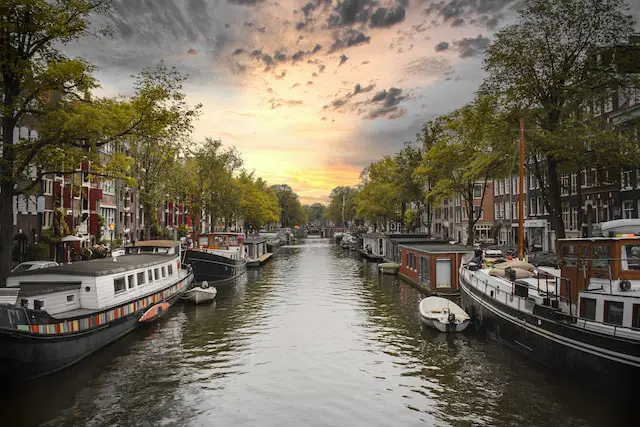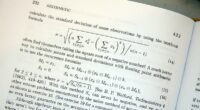Determinists believe that nature is the driving force behind environmental outcomes, while possibilists argue that humans have a significant impact on shaping their environment. Determinism and possibilism are two different schools of thought that have influenced the way we view human-environment interaction.
What is determinism?
(Photo by Jeremy Bishop on Unsplash )

Determinism is the idea that all events, including human actions and decisions, are ultimately determined by external factors. This theory suggests that everything we do or experience in life is a result of pre-existing conditions such as genetics, environment, upbringing, and social structures.
One key aspect of determinism is the concept of causality – the belief that every event has a cause and effect relationship with other events. According to determinists, if we could accurately predict the current state of these causal factors at any given moment in time, then we should be able to predict all future outcomes.
Some proponents of determinism argue that it can help us understand why certain individuals or societies develop in particular ways. They believe that by analyzing past events and their causes within specific contexts, we can gain insight into how similar situations might unfold in the future.
However, critics argue that determinism undermines our free will because it implies that our choices are predetermined by external forces beyond our control. They suggest instead that humans have agency over their lives and can actively make choices based on personal values and beliefs rather than being subject to deterministic laws.
What is possibilism?
(Photo by radwan skeiky on Unsplash )

Possibilism is a perspective that suggests that humans have the ability to alter their environment and overcome physical constraints. This idea emerged as a response to determinism, which claimed that environmental factors were the sole determinant of human behavior.
The possibilist view acknowledges the role of physical geography in shaping human behavior but asserts that people have the potential to modify or adapt their surroundings based on cultural beliefs, technology, and economic motivations.
This concept was first introduced by French geographer Paul Vidal de la Blache in the early 20th century. He argued that while nature may provide limitations, it is ultimately up to humans to determine how they interact with their environment.
The possibilist approach has been applied across various fields such as urban planning and architecture and has led to innovations like green infrastructure projects, sustainable building practices, and eco-friendly transportation systems.
Possibilism offers a more optimistic outlook on human-environment interactions by recognizing our agency in shaping our surroundings rather than being limited by them.
Determinism Vs. Possibilism – Key differences
Determinism and possibilism are two opposing views on the relationship between human beings and their environment. Determinists believe that environmental factors such as climate, topography, and natural resources determine the course of human history. They argue that humans have little control over their fate because they are constrained by environmental limits.
On the other hand, possibilists reject this deterministic view and argue that humans have much more agency in shaping their environment than determinists give them credit for. Possibilists contend that humans can adapt to changing environments through technology, innovation, and creative problem-solving.
The key difference between determinism and possibilism is therefore centered on the extent to which human actions are determined by external factors or influenced by individual willpower.
While determinists view nature as a limiting factor on human development, possibilists see it as a set of possibilities waiting to be explored. The former believes in predestination while the latter champions free will.
In essence, whether you subscribe to determinism or possibilism depends largely on how you perceive your own role in shaping your destiny: Are we passive victims of our surroundings or active participants who can shape our own future?
The debate between determinism and possibilism
The debate between determinism and possibilism is a long-standing one that has persisted in various fields, including geography, philosophy, and sociology. Determinists believe that events are predetermined by factors beyond human control, while possibilists argue that humans have the ability to shape their environment and actions.
One of the key points of contention in this debate is whether or not humans have agency. Determinists argue that our actions are simply a result of external factors such as genetics and upbringing. On the other hand, possibilists point out that we can change our behavior based on new information or experiences.
Another issue at play is how much influence environmental factors have on our lives. Determinists argue that climate, topography, and other physical features dictate what we can do in a particular area. In contrast, possibilists suggest that people can make changes to adapt to these conditions.
Ultimately, the debate between determinism and possibilism highlights some fundamental questions about human nature: Are we free agents capable of making choices? Or are we simply products of our environment? While there may be no clear answer to these questions, exploring them helps us better understand ourselves and our place in the world.
What is determinism and possibilism in geography?
Determinism and possibilism are two important concepts in geography that explain how the environment affects human activities. Determinism is a belief that the physical environment determines human behavior, while possibilism suggests that humans have the ability to adapt to their surroundings and can modify their behavior accordingly.
Determinists argue that people living in areas with harsh climates or difficult terrain will have limited opportunities for economic development, cultural expression, and social organization. They believe that environmental factors such as temperature, rainfall patterns, soil fertility, and natural resources influence everything from food production to transportation systems.
Possibilists reject this deterministic view of geography. Instead of being constrained by their surroundings, they argue that humans can overcome environmental limitations through technology innovation or cultural adaptation. For example, communities living in arid regions have developed irrigation systems to make agriculture possible despite minimal rainfall.
In summary, determinism emphasizes a dominant role for the environment in shaping human activities while possibilism stresses on human agency within an environmental context.
What is the difference between determinism and possibilism in the context of human environment interaction?
Determinism and possibilism are two contrasting theories that explain how humans interact with the environment. Determinism suggests that geography is the primary factor in shaping human activities, while possibilism posits that environmental factors only create possibilities for human actions but do not determine them.
In the context of human-environment interaction, determinists argue that environmental limitations such as climate, topography, and natural resources shape cultural development. They believe that societies living in arid regions will have limited agricultural practices and nomadic lifestyles. On the other hand, possibilists assert that even though a particular region may be arid or barren, technological advancements can provide alternatives to traditional agriculture practice such as hydroponics.
Moreover, another difference between these concepts lies in their degree of flexibility; determinism is deterministic whereas possibilism allows more room for adaptation. For instance, a society living close to water bodies tends to engage more in fishing activities than farming based on their easy access to fish sources.
Understanding these differences helps us appreciate the different perspectives towards environmental issues and how we can best adapt them to our advantage without compromising nature’s integrity.
What is an example of possibilism in the world?
Possibilism is the theory that suggests humans have the ability to modify their environment based on their needs and desires. One of the most famous examples of possibilism in action comes from the Netherlands, a country that has been shaping its landscape for centuries.
Due to its geographical location, Holland has always had to deal with flooding and water management issues. Instead of accepting these challenges as determinists would suggest and relocating elsewhere, Dutch engineers developed an intricate system of dams, dikes, canals and other hydraulic structures designed to control water levels.
The result is a fascinating network consisting of thousands of kilometers worth of man-made channels that allow people not only to coexist with nature but also thrive in it. The iconic windmills scattered across Dutch landscapes are another example of how possibilism can transform what seems like insurmountable obstacles into opportunities.
By harnessing renewable energy sources such as wind power, Dutch citizens were able not only to overcome natural barriers but also create new industries around them. Today, wind energy accounts for almost 20% percent of electricity generated in the Netherlands – proving once again that anything is possible when we learn how to work with our environment rather than against it.
What is an example of determinism in the world?
Determinism is a philosophical concept that states all events, including human actions, are predetermined and inevitable. It suggests that individuals have no free will as everything they do is predestined by factors beyond their control. An example of determinism in the world can be seen in the field of genetics.
Genetic determinism is the idea that an individual’s genetic makeup determines their behavior and personality traits. For instance, research has shown that certain genes are linked to aggression and violence. This implies that individuals who possess these genes may display aggressive tendencies irrespective of environmental or social influences.
Another example of determinism can be seen in weather patterns. The laws of physics dictate how rain falls from clouds, how wind moves through the atmosphere and how temperatures fluctuate throughout the year. These forces shape our environment regardless of human intervention.
It’s important to understand deterministic forces because they help us comprehend why things happen around us even though we might not actively influence them ourselves.
Featured Image By – Dorian Mongel on Unsplash








